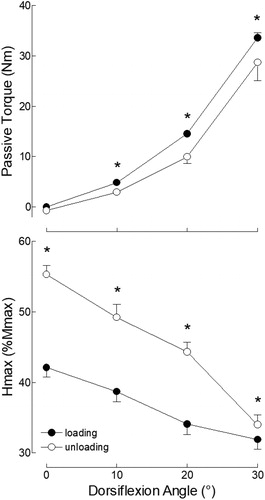1. Introduction
Muscle-tendon complex acts as a viscoelastic material (Taylor et al. Citation1990) that implies a decrease in passive torque during unloading compared with loading conditions, a phenomenon called hysteresis. Hysteresis of the muscle-tendon complex is manifest during a passive stretching maneuver as a lesser passive torque when relaxing the muscle (unloading phase) after stretching it (loading phase; Guissard et al. Citation1988). Hysteresis is assumed to take place in muscle rather than tendinous tissues (Kubo Citation2018). Meanwhile, the spinal neural loop that conveys information from muscle spindles is depressed, as indicated by the decrease in the amplitude of the Hoffmann (H) reflex, in soleus during and immediately after muscle stretching of plantar flexor muscles (Guissard et al. Citation1988). This suggests a decrease in the net excitatory input of group I afferents onto spinal motor neurons due to inhibitory mechanisms. However, the impact of hysteresis on H-reflex amplitude remains unknown. One could assume that a decrease in passive torque during the unloading phase may reduce inhibitory processes acting on H-reflex circuit. Such a result would suggest that part of the inhibitory mechanisms acting on H-reflex circuit is related to passive tension. The aim of the study was to compare the H-reflex amplitude in soleus during the loading and unloading phases of a stretching procedure of the plantar flexor muscles.
2. Methods
Thirteen young adults (24 ± 2 yr; 7 women) underwent a stepwise passive stretching of the plantar flexor muscles from an ankle angular position of 90° (referred hereafter as the neutral position: 0°) to a 30° ankle dorsiflexion angle. Tibial nerve electrical stimulation (1-s duration) was triggered to evoke maximal H reflexes (Hmax) and compound muscle action potentials (Mmax) in soleus. Hmax and Mmax were measured before and immediately after the stretching manoeuver (neutral position), and at 10, 20 and 30° of ankle dorsiflexion during the loading and unloading phases. The 30° dorsiflexion angle was maintained for 1 min while the 10 and 20-degree steps were held for 30 s. The Hmax amplitude was expressed as percentage of Mmax amplitude. Passive torque was continuously measured before, during and after the stretching manoeuver. Two-way analyses of variance (ANOVA) with repeated measures design [phase (loading vs. unloading) × angle (0, 10, 20, 30°)] were performed to compare the variables of interest (passive torque, Hmax and Mmax amplitude) between loading and unloading phases. Tukey post-hoc tests were used when angle main effect or phase x angle interactions was significant. The statistical significance was set at p < 0.05.
3. Results and discussion
The passive torque increased by 34 ± 14 Nm from the neutral to the 30° dorsiflexion angle (p < 0.001). The passive torque was significantly smaller during the unloading phase (phase main effect, p < 0.05), with significant lesser values at 10, 20 and 30° of ankle dorsiflexion during the unloading phase (phase x angle, p < 0.001; Tukey post-hoc test, p < 0.001) (, top panel). Mmax amplitude did not change throughout the stretching procedure (p > 0.05). The Hmax amplitude decreased during the loading phase from 42 ± 15%Mmax to 32 ± 19% Mmax (p = 0.031) and increased during the unloading phase from 34 ± 20%Mmax to 55 ± 17%Mmax (p = 0.023) (, bottom panel). Moreover, the Hmax amplitude was significantly greater during the unloading than the loading phase (phase main effect, p < 0.05), with significantly greater Hmax amplitude at 0, 10, 20 and 30° dorsiflexion angle during the unloading phase (phase x angle, p = 0.029; Tukey post-hoc test, p < 0.001).
Figure 1. Passive torque (top panel) and Hmax amplitude (expressed as percentage of Mmax; bottom panel) during the loading (filled symbols) and unloading (open symbols) phases at different dorsiflexion angle. Passive torque and Hmax amplitude increased and decreased, respectively, during the loading phase (p < 0.05). * indicates significant difference between the loading and unloading phases (p < 0.05). Data are illustrated as mean ± SE.

In agreement with previous work (Guissard et al. Citation1988), passive torque was lesser during the unloading than the loading phase, indicating energy dissipation as heat during the stretching manoeuver (hysteresis phenomenon). In contrast, our preliminary data indicate that Hmax amplitude was greater during the unloading than the loading phase. The decrease in Hreflex amplitude during the loading phase of a stretching manoeuver likely reflects neural inhibitory processes (Guissard and Duchateau Citation2006), which decrease during the unloading phase for the soleus muscle. These results suggest that the inhibitory mechanisms reducing the net excitatory group I afferent input onto motoneurones are related, at least in part, to the passive torque generated during stretching.
4. Conclusions
The decrease in passive torque due to the hysteresis phenomenon likely reduces inhibitory mechanisms acting on group I afferent pathways. These preliminary data shed a light on possible interaction between muscle-tendon hysteresis and spinal excitability during muscle stretch.
Acknowledgments
The authors thank Joanna Artigas and Noé Daniel for their assistance in data collection.
References
- Guissard N, Duchateau J. 2006. Neural aspects of muscle stretching. Exerc Sport Sci Rev. 34(4):154–158.
- Guissard N, Duchateau J, Hainaut K. 1988. Muscle stretching and motoneuron excitability. Europ J Appl Physiol. 58:47–52.
- Kubo K. 2018. Effects of static stretching on mechanical properties and collagen fiber orientation of the Achilles tendon in vivo. Clin Biomech. 60:115–120.
- Taylor DC, Dalton JD, Seaber AV, Garrett WE. 1990. Viscoelastic properties of muscle-tendon units. The biomechanical effects of stretching. Am J Sports Med. 18(3):300–309.
